Kopeshwar Temple near Kolhapur in Maharashtra is a masterpiece of Chalukyan temple architecture. It is yet to get fame like the Chola temples of Thanjavur or the Chandela temples of Khajuraho. Maybe because it is a single temple in this region with a much smaller Jain temple in the vicinity. Maybe its time has just come now.

Kopeshwar Mahadev Temple in Khidrapur was my prime motivation for this trip to Kolhapur. So, early morning we drove down from Kolhapur to Khidrapur, some 70 Km away, to see this temple in all its glory.
Kopeshwar Temple Khidrapur
Nested between the relatively new houses, the stone door with a lovely doorjamb welcomed us. The first thing I noticed was the shining polish the stones carried. I would soon see many sculptures and pillars inside with even better, shining polish on them. It reminded me of the fine polish I saw at Barabar caves in Bihar.

I stepped in to see the temple shimmering in the morning rays of the sun. I hurriedly stepped into the Swarg Mandap – for this is the most unique architectural feature of this temple. And stood there awestruck by what I saw. No matter how many images or videos you see, there is nothing like standing on the large circular stone disc surrounded by 48 carved pillars with an opening to the sky.
An elderly lady asked me to first go and meet the deity of the temple – Kopeshwar Mahadev. She is probably used to seeing tourists get lost in the sculptures and forgetting to meet the deity. I stepped inside the Sabha Mandap through another lovely stone door with a stunning doorjamb. Another set of pillars surrounding another large circular stone welcomed me. I wondered what dance and music this stone would have seen over the ages.
Madanika Sur Sundari
When I could take my eyes off the circular pillars and the stories, they have on them, I saw the single Dwarpala on the right side of Antral Dwar or the door leading to the vestibule. The other space was empty waiting for the Dwarpala Murti to be fixed, or was it there but removed by the thieves? Antral is full of Madanika or Sur Sundari images, the beautiful women who are adorned with all kinds of jewelry and are considered Mangala or auspicious.
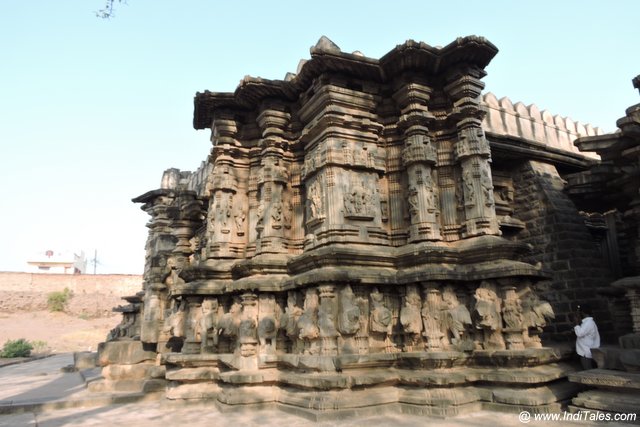
The Garbhagriha or the sanctum has two Lingas and there is an interesting legend about it. There are Madanikas on the walls of the sanctum as well. This is rare. The same lady pointed us to the meditation cave on the left and it felt like the perfect place to sit and meditate in complete darkness.
It was time to go around the outside walls of the temple. I was lost in the sculptures of Shiva, Brahma, Vishnu & Devi punctuated by Madanikas in various poses. I did notice a lovely Krishna Murti. However, it was when our guide Shashank came and explained to us the whole temple for more than an hour that each of these sculptures started talking to us, taking us back in time to when a Kalyani Chalukyan king would have probably first built it.
History of Kopeshwar Temple at Khidrapur
There are different views on when this temple was exactly built. Sources point to it being first built in the 7th CE, probably built by Badami Chalukyas. Other sources place it in the 9th CE during the times of Kalyani Chalukyas. While yet other sources put it to the 12th CE built by Shilahar Kings, who were earlier the vessels of Chalukyan kings.

My sense is that it is probably a 9th CE temple later enhanced by Shilahars. You do see a lot of incomplete elements in the temple. For example, the incomplete north and south Mukh mandapas, and incomplete carvings on pillars with markings for carving. As they say, incomplete structures give you insights into the making of temples. The Shikhar of the temple is also out of sync with the rest of the structure. Temples anyway are in perpetual construction mode.
The temple thankfully has 12 inscriptions, 11 of which are in old Kannada script while one is in Devnagari. However, none of these inscriptions tell us about who built it and when. One of them dating to 1204 by Yadava Kings of Deogiri does mention the renovation of the temple, implying that the temple existed well before 12th CE.
Marks of Aurangzeb’s visit in 1702 CE can be seen all over the broken images of the temple. Most faces and hands are broken, weapons are broken, as are the trunks of elephants that form the platform on whom the temple stands.
The story of Kopeshwar Mahadev
They say in Sanatan Dharma, every story eventually goes back to the story of Sati’s self-immolation at her father Daksha’s Yagya. Kopeshwar Mahadev celebrates a moment of that key episode. After Sati kills herself, Shiva is angry. Vishnu steps in to pacify his anger. It is at that moment that this temple freezes in time. Since Shiva is angry he gets the name Kopeshwar. Kopa means anger in Sanskrit. Vishnu is present here as the second linga to pacify Shiva.
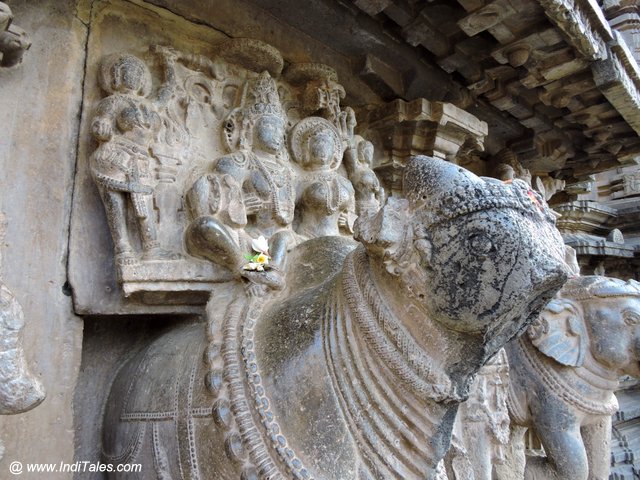
Nandi, an integral part of every Shiva temple is missing here. Not without a reason. When this episode happened, Nandi had accompanied Sati to her father’s place. So, he is absent here. Now, Daksha’s place is in Kankhal in Haridwar, but people in Maharashtra believe it to be in Yadur village a few kilometers across the Krishna river. The Nandi there at the Virbhadra temple seems to look towards this temple. I missed visiting this temple, but probably next time.
I wonder if the presence of so many Madanikas, especially in the sanctum is to pacify the Shiva, who is Kopeshwar here.
The Architecture of Kopeshwar Temple Khidrapur
Architecturally, so as per Shilpa Shastra, this is probably the richest temple in Maharashtra.
The stone used in this temple is hard basalt rock, that is found in the Sahyadri range of mountains, the closest point being 60 km away. So, the stone must have been ported here via Panch Ganga and Krishna rivers. Most of our rivers had good waterways once upon a time.
Let us look at the architecture of this beautiful temple in detail.
Swarga Mandap

The Swarga Mandap – an exquisitely carved structure, with a circular open ceiling is the most unique feature of this temple. I have not seen anything like this anywhere in temples across India. To the best of my knowledge, have never even heard of anything like this anywhere.
Swarga Mandap is the first part of the temple that you see once you step in. It is detached from the main temple by a very small margin. The circular structure of Swarga Mandap is supported by 48 pillars, each of which is beautifully carved. Seen from the outside, you can see the impression of an inverted lotus on the roof.

There are 12 horizontal spokes coming out on the ceiling, both inside and outside the structure.
12 Deities
The inside edge has 12 deities carved on them. There are 8 deities of 8 directions, collectively called Digpals occupying their respective direction. In addition, there are 4 images of Vishnu, Kartik, the Sun, and Shiva. All the deities are riding their respective vehicles with their consorts except Kartik who is believed to be a Brahmachari or single.

Figures are carved in a manner that if you stand in the middle, you will only see the deity riding alone. It is only when you step aside, you will see the consorts sitting behind them. You simply smile at the craft of the architect who designed it & you wonder when, why, and how did we lose it all!
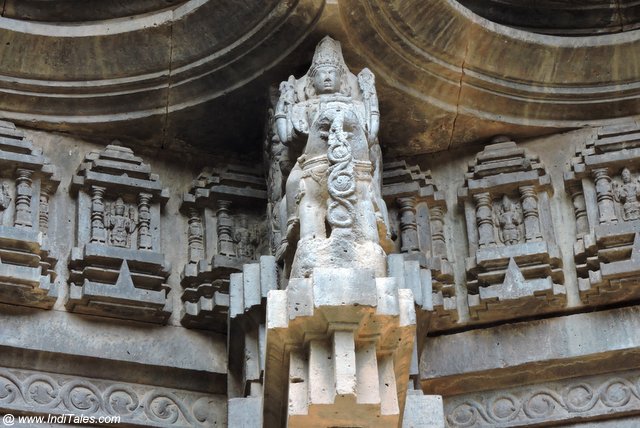
The circular stone slab on the floor called Rangshila is exactly the same size as the hole in the ceiling. It roughly measures 14 feet in diameter and is carved out of a single stone. Talk about mathematics in our temple architecture.
Video of Kopeshwar Temple Khidrapur
48 Pillars surrounding the open space in Swarga Mandap are carved in geometric patterns. The polish is to be seen to be believed, almost metallic finish. Of these, 12 pillars surround the Rangshila. At the bottom of these pillars are the different temple architecture designs carved, especially the shikhara styles. A slim strip going around the pillars has different flowers carved on it.
An obvious question that comes to your mind is why would the ceiling be open. A logical answer that I got was that this place was used to perform Yagnas, so an open ceiling was required. Another explanation said it is to be able to see the Sky from inside the temple. Sky, as we know, is one of the five elements that everything is supposed to be made from. The name. Swarg Mandap comes from this window to the sky, as it is believed that you see the Swarga or heaven from here.
Open Sky Architecture
I did wonder if the roof is missing because the temple is not yet complete or if it fell off at a certain point in time. My curiosity was answered when I saw a well-built channel to take the water out of the mandap. So, it was always meant to be open to the sky.
It was probably also used for cultural performances as you can see a rough seating arrangement at different levels around it. It gives an impression of a mini-amphitheater. Does the sky window has an acoustic role, that needs to be explored?
Once I soaked in the charms of Swarga Mandapa, I looked towards the temple, standing in the middle of the Rangshila of Swarga Mandap. What amazes you is that the trinity of Sanatan Dharma, Brahma, Vishnu, and Mahesh are all visible in one frame. Shiva is inside the temple as the presiding deity, Brahma can be seen on the left wall of the temple, and Vishnu on the right. Interestingly, you only see three of them from this point and no other deity.
Sabha Mandap
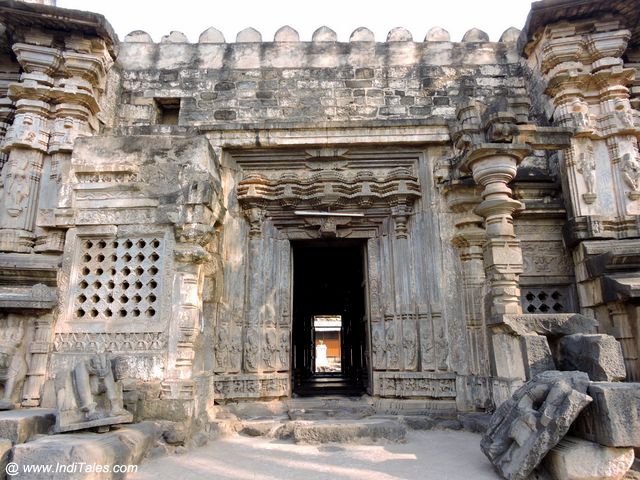
The Sabha Mandap is a part of the main temple, slightly detached from Swarga Mandap. The doorjamb is beautiful with a Saraswati Murti on top and Purna Kalash on both sides. Lower panels on both sides of the door have 10 Dwarpalas, 5 on each side. Figures are well ornamented and adorned. They look beautiful even when their Gadas have been broken. At the bottom is a panel of mythical animals called Vyals.

The lattice windows with flowers carved at intersections are a signature element of Chalukyan architecture. An incomplete Chandrashila is carved in front of the door.
Inside the Sabha Mandap, the geometry of Swarga Mandapa is repeated except the ceiling is covered here. 60 pillars are arranged in 3 layers, a square in the middle and the third layer embedded in the walls. The four corner pillars are bigger than the rest of the pillars.

Each pillar has Kirtimukh carved on it, each in a different style with different motifs. Some of the motifs include Peacocks, Crocodiles, Dancers, Vahanas like Garuda, and deities like Vishnu, Shiva, Sadhus, Fruits, and Flowers. Polish on black basalt stone shines like a mirror.
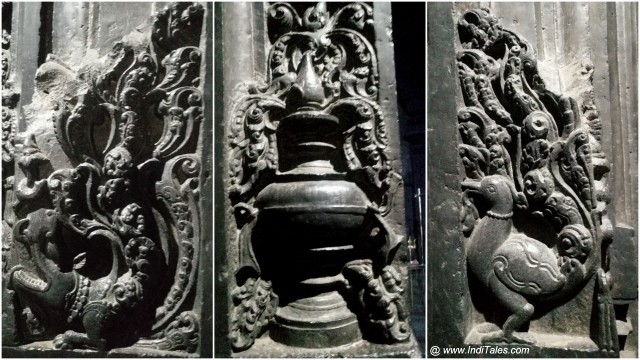
Pillars
In some of the pillars, we admired the miniature version of sculptures where no single detail was missing. A small carving of Vishnu and Lakshmi has all the jewelry properly carved with all the iconographic details that help you identify the deity.
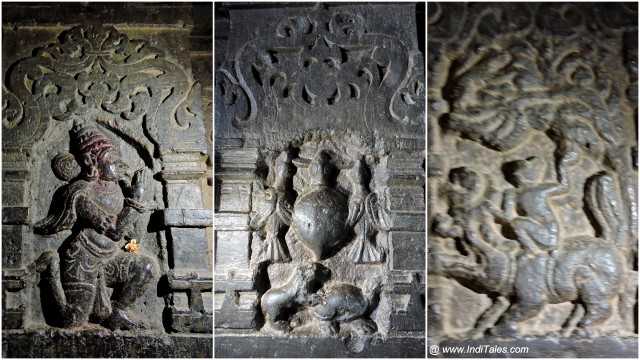
There are two Jataka or Panchatantra tales that can be seen carved on the pillars. One is that of a Monkey and a Crocodile, another is that of the talkative tortoise. There is a depiction of Vasant Ritu or the spring season. There are mirror images of dancers and animals. A Ramayana panel showcases Hanuman with Ram & Lakshman. The carvings of some of the pillars are in an incomplete stage.
A circular Rangshila again takes center stage here. The performances here would have been like a Pooja offered to the deity inside the Garbhgriha.
In one corner is the image of Saptamatrika on a stand-alone stone. A Bhairava Murti in one of the niches looks like a later addition.
Dwarpala

The masterpiece of Sabha Mandap is the Dwarpala outside the Antral or vestibule. It is heavily embellished and the jewelry designs can still be seen in the markets of Kolhapur. The crown has a row of Mund-Mala or the garland of skulls. The jewelry is brilliant and the finish is so fine.
Antral or Vestibule
Square Antral or Vestibule again has some lovely carved figures and a place to see the temple doorjamb. On the right wall of the vestibule is a longish inscription in old Kannada.
Garbhghriha or Sanctum
We crossed a finely carved Chandrashila with conch shells and crocodile carvings to enter the Garbhgriha. On top of Doorjamb is Lakshmi. There is a depiction of life around the door and auspicious figures like Purna Kumbha, Makar & Mayur or Pots, Crocodiles, and Peacocks.

A unique feature of the Grabhgriha of this temple is that you find the Madanika figures all around the walls of the sanctum. Unfortunately, most of them have been broken.
The two Lingas depicting Shiva and Vishnu are at the base level. A pujari regularly worships them.
Kopeshwar & Dhopeshwar Lingas
As I said earlier, the Garbh Griha has two Lingas – one representing the Shiva as Kopeshwar. The second one represents Vishnu as Dhopeshwar, as the pacifier of Shiva. Since this temple celebrates that moment, both Shiva and Vishnu are present in Linga form here.

We witnessed a unique Shringar of the Kopeshwar Shivalinga here with Dahi-Bhaat or Rice and Curd. As you know this is a cooling combination, so this is applied to the deity every day during the summer months from Maha Shivratri till Ashadh Shukla Panchami. This is called Bhukti Puja in Kannada and Dahi Bhat Puja in Marathi.
I have never seen such a beautiful Abhishek in any temple. Pujari spent 4 hours in the morning creating a Shiva figure on the linga, a Nandi, and a Ganesha figure around it with Dahi Bhaat. This is done every day for these two months. If you want to see the complete Shringar, visit during these two months and be there around noon time.
It was also heartening to see the kids from nearby schools visiting the temple before going to the school next door in their white and pink check uniforms.
Mahashivratri is the biggest festival celebrated at Kopeshwar Mahadev Temple. Every Monday, a procession of the Utsav Murti takes place in the temple.
Outside Walls of the Kopeshwar Temple
The walls of the temple are as unique as the temple.

At eye level is a panel with 92 elephants that goes around the temple, giving you a feeling that these elephants are carrying the temple on their backs. This is unique to this temple. Each of the 92 elephants is carved differently. Each elephant has different jewelry and has different deities riding them.
Unfortunately, most have their trunks broken by the invaders. Some that have survived show you a glimpse of how beautiful they would have looked holding fruits like Mangoes and Sugarcanes. You can see this elephant panel replicated at the Akshardham Temple in Delhi.

On all three sides of the temples are images of Shiva and Parvati with images of Brahma and Vishnu on either side. All of them are carved in a very different way, there is no repetition. The gargoyle in the shape of a crocodile is beautiful. Its water falls into a unique star-shaped tank.
Deities on Outer Walls
The four corners of the Sabha Mandap have major deities carved on them. Deities like Brahma, Vishnu, Ganapati, Krishna as Murlidhara, Shiva, Devi, Bhairav, Bali, Vaman, Chandra, Surya, Ardhnarishwara, Madan, Rati, Saraswati, Ganga, Mahishasurmardini, Nataraja can be seen in various poses.
There are scenes from Mahabharata with Bhim & Draupadi & Ramayana with Hanuman seen with Ram and Sita holding the ring. Most deities are riding the elephants except Shiva and Parvati who are always on their Nandi.
There is a broken Murti of the second Dwarpala near the left or southern door of the Sabha Mandap. The door on this side shows 7 out of 10 Dwarpalas are women.
Close to it is the inscription in Sanskrit in Devnagari Script that tells about the renovation of the temple by Snghan Dev of Yadavas in 1214 CE. The inscription has the sun and moon on the top. A Shivalinga is being worshipped by a Purohit below them along with a cow and a sword. The conch shell on the left is the royal emblem of Yadavas who trace their descent from the Vishnu Avatar of Krishna.
On both the southern and northern doors of the Sabha mandap, you can see the incomplete structures that were planned but were never completed. Can we complete them in the 21st CE? Yes, provided we had the skills to carve the stone so beautifully.
Madanika
Madanikas is exquisite at this Khidrapur Temple.
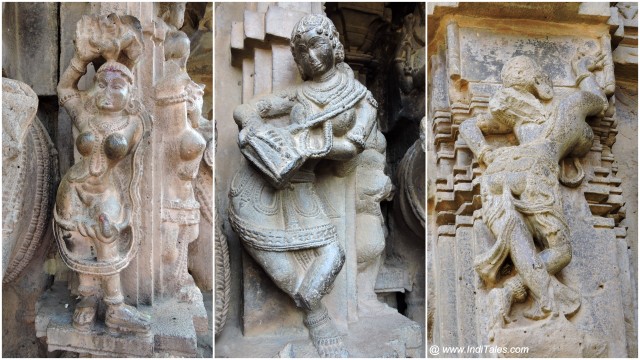
Some of the ones I can recall are:
- Mridangvadini – or the one who is playing Mridanga, also known as Mardala.
- Vishkanya – with a snake on her feet & hands
- Shuk Sarika – One with Parrot
- Patralekha – one writing the letter. There are three sculptures here showing the beginning, middle, and end of letter writing in this temple.
- Marichika – the one holding a bow in her hands
- Madanika with a Monkey pulling her garment
- Chamravahini – the one who holds the Chamar or Whisk in her hand
- Nartaki – dancers in different poses
- Veenavadini – one holding the Veena
- Shalbhanjika – the one holding the branch of a tree
- Bhujang Trasita – the one who is scared to see a snake
- Kanduk Kreeda Magan – the ones lost in playing with the ball
- Playing Holi with a Pichkari in hand
If you look intently you will see almost all fashion trends from across the ages depicted here. Part curls, part straight hair, nail art, shorts, high heels, different hairstyles, accessories, jewelry designs, belts, mirror work, adornments – everything can be found on these Madanika sculptures.
The sculptures in the inside folds of the temple walls which have managed to escape the sun and rain, shine as if they have been polished yesterday. You have to imagine how the temple would have looked when all the images shined the same way.
Somewhere among Madanikas, you see a couple of foreigners with distinct beards, probably Arabians and Chinese. I wonder if these two are always found in our sculptures to show the trade with both the East and West.
Shikhara
When you stand on one side of the temple and look at the structure as a whole, you would notice a stark mismatch in the architecture of Shikhara or the superstructure and the rest of the temple. It was probably added later, probably in a hurry to complete the incomplete temple.
After going in and out of the temple many times, trying to capture whatever I can with my cameras and my eyes, it was time to say Goodbye. Not before, this temple entered my list of Must See Temples in India.
Jain Temple at Khidrapur
About 200 meters away there is a smaller Jain temple, built in the same fashion as this temple, but a much smaller one. The temple is dedicated to Adinath – the first Tirthankar of the Jains.
The shikhara of the temple is painted and has Jain Murtis but the main temple in stone has some lovely Madanika figures.
A tall Nandi Deep stands in front of the temple.
How to Reach Kopeshwar Temple?
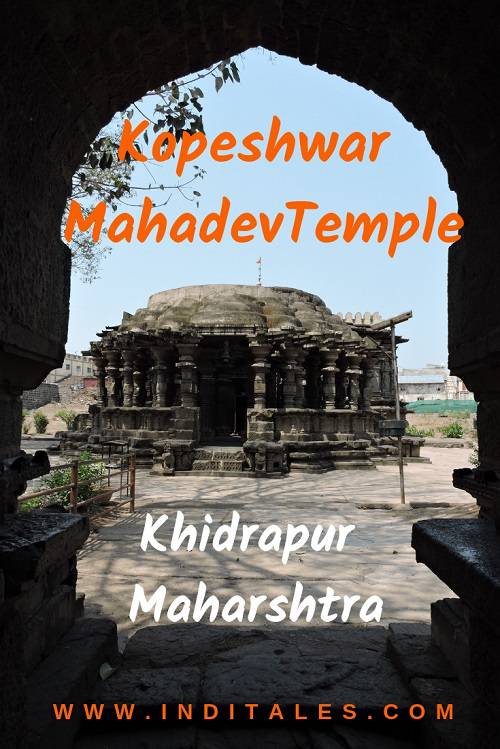
It takes 2 hours to drive from Kolhapur, in the morning it took us some 90 mins though.
You can visit Narsimhawadi at the confluence of Panch Ganga and Krishna Rivers and the newly built Ganesh Temple at Jaisingpur along with this temple. Do stop by at the Jain temple close by.
I did spend 6-7 hours at the temple. You must budget at least 2 hours here.
I recommend MTDC-approved guide Sh. Shashank Chothe. You can contact him at shashank5889@gmail.com or 88880 05889 to see the temple in detail.
Temple is open from sunrise to sunset. In fact, it is an open temple, you can visit at any time.
Photography is allowed in Swarga Mandap and outside the temple. For inside seek permission from the priest or ASI officials.






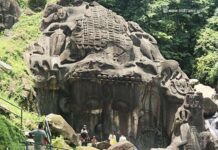
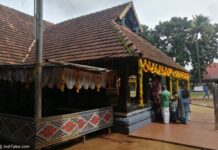
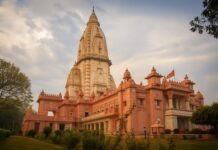





Awesome, i did walk with you while reading.
I have been to khidrapur, but honestly i did fail to notice on few things. Yours mentions are very intricate.. loved it
So glad that you enjoyed walking with me at Kopeshwar Temple. Stay connected.
Have been there, Its lovely. And god knows how you gather all that information! Respect !!!
Emm, thank you. I read as much as I can before I visit a place, and then I meet local people. Now, because of Inditales and social media, I also get a lot of help from local people.
Thanks for sharing a valuable article. Useful blog. Keep Sharing articles like this…..
Nice and very informative article
Thank you Pradip Ji.
This place looks fascinating. Might have to add it to my itinerary for India 2020!
I love your blog. Very informative, this year I am planning to visit India. Such a beautiful pics you have shared. I am excited to visit this summer…
Summers are hot in India, but then you can always head to the mountains. Hope you get to see some of our stunning temples.
Great piece of architecture. Thanks for sharing.
This looks masterpiece of architecture.Never heard about this temple and this looks so stunning.Would love to visit.And mam your blogs are so detailed.Don’t know how you manage to write so detailed and informative????.
Always inspirational.
This looks masterpiece of architecture.Never heard about this temple before and looks stunning.Would love to visit.And mam your blogs are so detailed.Don’t know how you manage to write so detailed and informative????.
Always inspirational.
Thanks, Mayuri. I love being at these places and my wonder on seeing such brilliance probably flows into my writing. I also try to read as much as possible before writing.
amazing….one of the best example of civil work.
one of the best example of civil work. An inspiration for civil engineers.
This is very glamorous article written on ancient temple Every point is discussed admirable artical Thanks for highlighting the ancient monument
Very beautifully written
Almost with u thru d reading
Putting on d list of must visit places
Great work by u
Love it
Grt work Anuradhaji…will love to discover some more temples of India with your blog…keep writting????
Very good. Our team of conservation architects has been recently appointed for the conservation of the temple and we will benefit from the various perspectives about the temple it’s origins, concepts, design, iconography, mythology, architectural elements, and so many other aspects that deal with it’s interpretation and conservation. Thanks for your interesting article.
I am really Thankful for this wonderful information brought out ????????
This is a brilliant write up. Do keep sharing more and more on our ancient architecture and history
There are similar structures as the Swarga Mandapa or Mukha Mandapa at the Surya Mandir at Modhera and the Shiva temple at Arsikere in Karnataka.
I’m a regular visitor to this temple yet I didn’t know the information of this temple…. As you said we always forget to visit the deity by looking at the beauty of the temple….
Thank you for sharing the information in detail.
Thanks for this article
It’s valuable one. I should hv read this article before visiting this temple. Though I was not allowed to see it properly. I missed the jain temple and the mahalakshmi temple for shortage of time and unawareness..Thanks again. We should take up a mission to save this temple from further dilapidation.
I am doing this by talking about and documenting temples, as much as I can. Please join in.
Irony to see that nowhere you mentioned contribution of Shilhara Kings in development of this temples.
What a beautifully detailed post! The intricate carvings and unique architecture of the Kopeshwar Temple truly capture the essence of ancient craftsmanship. I love how you highlighted both the historical significance and the artistic elements. It makes me want to visit and experience the temple in person! Thank you for sharing such insightful information!
This post beautifully captures the intricate details of Kopeshwar Temple. The blend of artistry and history is truly mesmerizing! I can’t wait to visit and see the stunning architecture in person. Thank you for sharing such valuable insights!
What an incredible exploration of the Kopeshwar Temple! The intricate carvings and stunning architecture truly showcase the craftsmanship of the era. I love how you brought to light the historical significance behind the temple. It’s definitely added to my must-visit list!
What an incredible exploration of the Kopeshwar Temple! The intricate carvings and architectural details truly reflect the rich cultural heritage of the region. Your vivid descriptions made me feel like I was walking through its hallowed halls. I can’t wait to visit and see this stunning temple in person! Thank you for sharing such an enlightening post!
What a captivating exploration of the Kopeshwar Temple! The intricate carvings and architectural details really bring out the incredible craftsmanship of that era. I appreciate how you highlighted the historical significance of the temple as well. It’s definitely going on my travel bucket list!
This post beautifully captures the intricate details of the Kopeshwar Temple! The architectural marvel and the rich history behind it are truly fascinating. I can’t wait to visit and see these stunning carvings in person! Thank you for sharing such an insightful piece.
What a beautifully detailed exploration of the Kopeshwar Temple! The intricate carvings and stunning architecture truly reflect the rich heritage of Indian craftsmanship. I love how you highlighted the historical significance as well. It makes me eager to visit and experience the temple in person! Thank you for sharing such insightful content!
What an incredible insight into the stunning architecture of Kopeshwar Temple! The detailed descriptions and captivating photographs really brought the temple’s intricate carvings and historical significance to life. I can’t wait to visit and experience its beauty firsthand. Thank you for sharing such a comprehensive exploration of this hidden gem!
What a captivating post! The intricate details and stunning architecture of the Kopeshwar Temple truly illustrate the rich heritage of Karnataka. I loved the way you highlighted the unique carvings and the historical significance of the temple. It makes me want to visit and experience its beauty in person! Thank you for sharing such insightful information.
What a captivating overview of the Kopeshwar Temple! The intricate carvings and historical significance truly showcase the artistry of that era. I love how you’ve highlighted the unique architectural features. Can’t wait to visit and experience this beauty in person!
What a captivating exploration of the Kopeshwar Temple! The intricate carvings and rich history you’ve highlighted truly bring the temple to life. I can’t wait to visit and experience its beauty for myself. Thank you for sharing such insightful details!
What a fascinating exploration of the Kopeshwar Temple! The intricate carvings and architectural details truly reflect the artistry of that era. I’m inspired to visit and experience its beauty firsthand. Thank you for sharing such insightful information!